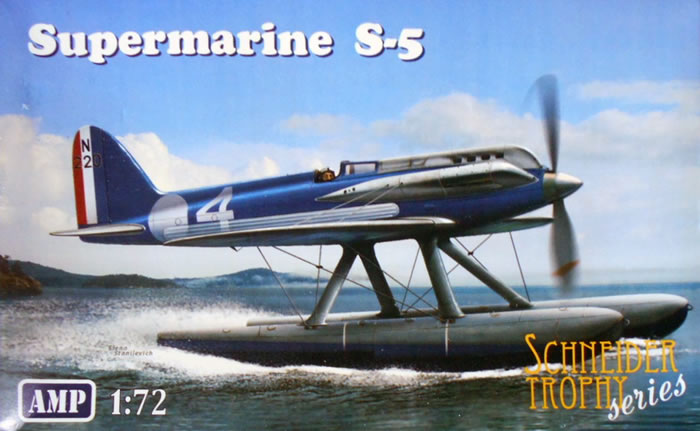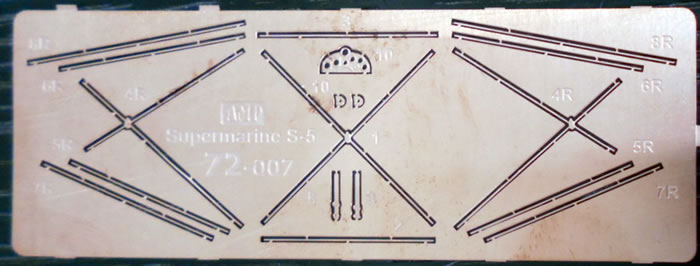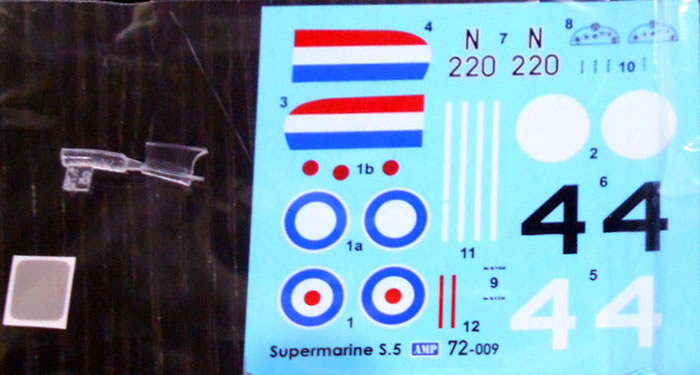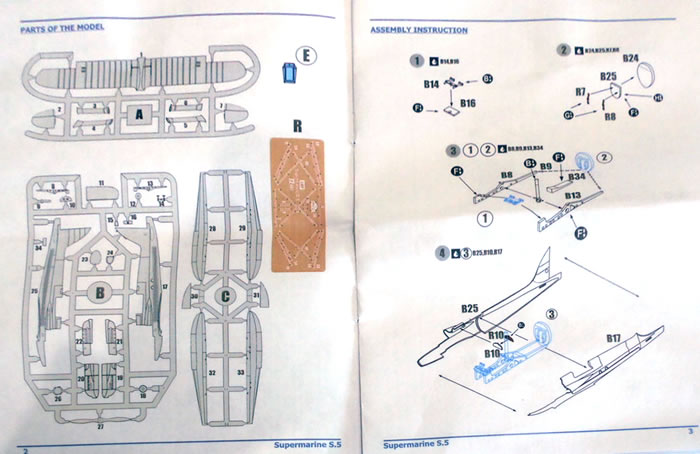Supermarine S-5

AMP, 1/72 scale
S
u m m a r y : |
Description and Item No.: |
AMP Kit No. 72009 - Supermarine S-5 |
Contents and Media: |
31 parts in grey low pressure plastic; one photo-etched fret with around 36 parts; two resin parts; two parts in clear(ish) plastic; instructions; decals for two marking options. |
Price: |
AUD$36.00 plus shipping available online from Creative Models Australia
and hobby retailers worldwide |
Scale: |
1/72 |
Review Type: |
First Look |
Advantages: |
Rare subject, nice moulding, detailed cockpit, exquisite trailing edges and clear instructions. |
Disadvantages: |
Flimsy box , mystery masks and some confusion with colour of fuselage radiators. |
Recommendation: |
This is a great addition to a collection of racing floatplanes, nice moulding and the PE rigging will really help. |
Reviewed by Graham Carter

The Supermarine S5 is an important aircraft in the history of the Schneider Trophy as it won the 1927 event that led to victories fro Great Britain in 1929 ( S6) and 1931 (S6B) to hold the trophy in perpetuity.
This is, I think, the first 1/72 version of this aircraft apart from a resin kit from a few decades ago. It has been available in 1/48 from AMP and, for a substantial price, in resin and white metal from Marsh Models Aerotech in 1/32. It is great that some of the Eastern European companies are satisfying the demand for these elegant iconic racers and this reviewer certainly hopes to see others such as the S4 and the whole Macchi family being produced.
A flimsy end-opening box contains loose instruction and a plastic resealable bag containing the parts. There are three sprues and another bag with the decals and PE fret, a tiny clear windscreen and two small grey shapes which are not mentioned anywhere in the instructions or on the parts map, but which I think are masks for the windscreen.
The three sprues hold the 36 plastic parts for the
-
floats,
-
flying surfaces and struts, and
-
fuselage.
Parts are cleanly moulded with next to no flash and very fine details, especially the cockpit interior. As a short-run kit it lacks locating pins and holes so care will be needed in alignment during construction.
The PE fret is in a coppery finish and provides the main rigging wires, seatbelts, instrument panels and hitching shackles for the floats. The wires will be especially useful.

Decals cover the single airframe N220 in three different stages - at the factory in 1927, the winner of the 1927 Schneider Trophy race in Venice, Italy and finally in RAF markings to set the World Speed Record in 1928.

Instructions are in colour on two A4 folded double-sided sheets into an A5 booklet contains a description of the aircraft in English and Cyrillic, and twelve nicely drawn clear construction steps. One issue is that the colour scheme drawings show a black stripe along each fuselage side - modellers beware!. My research shows these to be radiators and should be a silvery bronze as shown on the back of the box.

The cockpit is pretty complete with moulded fuselage details plus nine plastic and three PE parts. Not a lot will be visible unfortunately a the cockpit opening is tiny.
The nose is made up of three parts which will need careful alignment. There are two central sections provided to allow depiction of either the racer or the speed record versions but the difference is not made clear in the instructions. In all cases the exhaust recesses will need some reaming out in a couple of places as there is some flash here. It looks like the float assembly a struts will work well and easy to align.
This is a great addition to a collection of racing floatplanes, nice moulding and the PE rigging will really help.
Purchased by reviewer
Text and Images Copyright © 2020 by Graham Carter
Page Created 17 September, 2020
Last updated
17 September, 2020
Back to HyperScale Main Page
Back to Reviews Page |
Home
| What's New |
Features |
Gallery |
Reviews |
Reference |
Forum |
Search